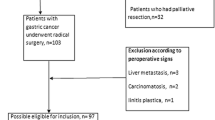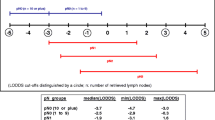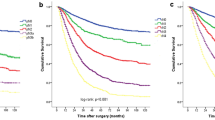Abstract
Introduction
The depth of the tumor invasion and nodal involvement are the two main prognostic factors in gastric cancer. Staging systems differ among countries and new tools are needed to interpret and compare results and to reduce stage migration. The node ratio (NR) has been proposed as a new prognostic factor.
Materials and Methods
We retrospectively reviewed 282 patients who underwent curative resection for gastric cancer at Parma University Hospital between 2000 and 2007. TNM stage, NR, overall survival, survival according to nodal status, and survival according to the total number of nodes retrieved were calculated.
Results
At univariate analysis, the TNM stage, number of metastatic nodes, NR, and depth of tumor invasion, but not the number of nodes retrieved, were significant prognosis factors. Patients with more than 15 nodes retrieved in the specimen survived significantly longer (p < 0.04). This was confirmed for all N or NR classes within N groups. There was a correlation between the number of nodes retrieved and N but not with the NR category. NR was an independent prognostic factor at Cox regression.
Conclusion
NR is a reliable and sensitive tool to differentiate patients with similar characteristics, probably more so than the TNM system. NR is not strictly related to the number of nodes retrieved and this may potentially decrease the stage migration phenomenon. More trials are needed to validate this factor.


Similar content being viewed by others
References
Nitti D, Marchet A, Olivieri M et al. Ratio between metastatic and examined lymph nodes is an independent prognostic factor after D2 resection for gastric cancer: analysis of a large European monoinstitutional experience. Ann Surg Oncol 2003;10(9):1077–1085.
Siewert JR, Bittcher K, Stein HJ et al. Relevant prognostic factors in gastric cancer: ten years results of the German gastric cancer study. Ann Surg 1998;228:449–461.
Bozzetti F, Bonfanti G, Morabito T et al. A multifactorial approach for the prognosis of patients with carcinoma of the stomach after curative resection. Surg Gynecol Obstet 1986;162(3):229–234.
Hohenberger O, Gretschel S. Gastric cancer. Lancet 2003;362:305–315.
Dicken BJ, Bigam DL, Cass C et al. Gastric adenocarcinoma: review and considerations for future directions. Ann Surg 2005;241:27–39.
Greene FL, Page DL, Fleming ID, Fritz A, Balch CM, Haller DG, Morrow M, eds. American Joint Committee on Cancer: AJCC Cancer Staging Manual, 6th ed. New York: Springer, 2002.
De Manzoni G, Verlato G, Roviello F et al. The new TNM classification of lymph node metastasis minimises stage migration problems in gastric cancer patients. Br J Cancer 2002;87(2):171–174.
Feinstein AR, Sosin DM, Wells CK. The Will Rogers phenomenon. Stage migration and new diagnostic techniques as a source of misleading statistics for survival in cancer. N Engl J Med 1985;312:1604–1608.
Inoue K, Nakane Y, Iiyama H et al. The superiority of ratio-based lymph node staging in gastric carcinoma. Ann Surg Oncol 2002;9(1):27–34.
Yoshikawa T, Sasako M, Sano T et al. Stage migration caused by D2 dissection with para-aortic lymphadenectomy for gastric cancer from the results of a prospective randomized controlled trial. Br J Surg 2006;93(12):1526–1529.
Liu C, Lu P, Lu Y et al. Clinical implications of metastatic lymph node ratio in gastric cancer. BMC Cancer 2007;7:200.
Bonenkamp JJ, Hermans S, Sasako M et al. Extended lymph-node dissection for gastric cancer. N Engl J Med 1999;340:908–914.
Marchet A, Mocellin S, Ambrosi A et al. The prognostic value of N-ratio in patients with gastric cancer: validation in a large, multicenter series. Eur J Surg Oncol 2008;34(2):159–165.
Celen O, Yildirim E, Gülben K et al. Prediction of survival in gastric carcinoma related to lymph node grading by the new AJCC/UICC or the Japanese system. Eur J Surg Suppl 2003;588:33–39.
Saito H, Fukumoto Y, Osaki T et al. Prognostic significance of the ratio between metastatic and dissected lymph nodes (n ratio) in patients with advanced gastric cancer. J Surg Oncol 2008;97(2):132–135.
Marchet A, Mocellin S, Ambrosi A et al. The ratio between metastatic and examined lymph nodes (N ratio) is an independent prognostic factor in gastric cancer regardless of the type of lymphadenectomy: results from an Italian multicentric study in 1853 patients. Ann Surg 2007;245(4):543–552.
Xu DZ, Geng QR, Long ZJ et al. Positive lymph node ratio is an independent prognostic factor in gastric cancer after D2 resection regardless of the examined number of lymph nodes. Ann Surg Oncol 2009;16(2):319–326.
Persiani R, Rausei S, Biondi A et al. Ratio of metastatic lymph nodes: impact on staging and survival of gastric cancer. Eur J Surg Oncol 2008;34(5):519–524.
Japanese Research Society for Gastric Cancer. The general rules for the gastric cancer study in surgery and pathology. Part 1. Clinical classification. Jpn J Surg 1981;11:127–139.
McCulloch P, Niita ME, Kazi H et al. Gastrectomy with extended lymphadenectomy for primary treatment of gastric cancer. Br J Surg 2005;92(1):5–13.
Hartgrink HH, van de Velde CJ, Putter H et al. Extended lymph node dissection for gastric cancer: who may benefit? Final results of the randomized Dutch gastric cancer group trial. J Clin Oncol 2004;22(11):2069–2077.
Wang XF, Sun YH, Liang DJ, Wang C et al. Clinical values of extended lymph node dissection for gastric cancer: a meta-analysis for D1 versus D2 gastrectomy. Zhonghua Wei Chang Wai Ke Za Zhi 2007;10(5):425–430.
Kulig J, Popiela T, Kolodziejczyk P et al. Standard D2 versus extended D2 (D2+) lymphadenectomy for gastric cancer: an interim safety analysis of a multicenter, randomized, clinical trial. Am J Surg 2007;193(1):10–15.
McCulloch P, Nita ME, Kazi H, Gama-Rodrigues J. Extended versus limited lymph nodes dissection technique for adenocarcinoma of the stomach. Cochrane Database Syst Rev 2004;(4):CD001964.
Ichikura T, Chochi K, Sugasawa H. Modified radical lymphadenectomy (D1.5) for T2-3 gastric cancer. Langenbecks Arch Surg 2005;390(5):397–402.
Bunt AM, Hermans J, Smit VT et al. Surgical/pathologic-stage migration confronts comparisons of gastric cancer survival rate between Japan and Western countries. J Clin Oncol 1995;13:19–25.
Ichikura T, Tomimatsu S, Uefuji K et al. Evaluation of the New American Joint Committee on Cancer/International Union against cancer classification of lymph node metastasis from gastric carcinoma in comparison with the Japanese classification. Cancer 1999;86(4):553–558.
Roder JD, Böttcher K, Busch R et al. Classification of regional lymph node metastasis from gastric carcinoma. Cancer 1998;82(4):621–631.
Wagner PK, Ramaswamy A, Rüschoff J et al. Lymph node counts in the upper abdomen: anatomical basis for lymphadenectomy in gastric cancer. Br J Surg 1991;78(7):825–827.
Bando E, Yonemura Y, Taniguchi K et al. Outcome of ratio of lymph node metastasis in gastric carcinoma. Ann Surg Oncol 2002;9:775–784.
Volpe CM, Driscoll DL, Douglass HO Jr. Outcome of patients with proximal gastric cancer depends on extent of resectionand number of resected lymph nodes. Ann Surg Oncol 2000;7(2):139–144.
Yu W, Choi GS, Wang I et al. Comparison of five systems for staging lymph node metastasis in gastric cancer. Br J Surg 1997;84:1305–1309.
Karpeh MS, Leon L, Klimstra D et al. Lymph node staging in gastric cancer: is location more important than number? An analysis of 1,038 patients. Ann Surg 2000;232(3):362–371.
Kato M, Saji S, Kawaguchi Y et al. A comparison of the prognostic significance between the number of metastatic lymph nodes and nodal stage in gastric carcinoma. Hepatogastroenterology 1999;46:3281–3286.
Hermanek P. The superiority of the new International Union Against Cancer and American Joint Committee on Cancer TNM staging of gastric carcinoma. Cancer 2000;88:1763–1765.
Katai H, Yoshinura K, Maruyama K, Sasako M, Sano T. Evaluation of the new International Union Against Cancer TNM staging for gastric carcinoma. Cancer 2000;88:1796–1800.
Kodera Y, Yamamura Y, Shimizu Y et al. Lymph node status assessment for gastric carcinoma: is the number of metastatic lymph nodes really practical as a parameter for N categories in the TNM classification? J Surg Oncol 1998;69:15–20.
Gunji Y, Suzuki T, Hori S et al. Prognostic significance of the number of metastatic lymph nodes in early gastric cancer. Dig Surg 2003;20(2):148–153.
Cheong JH, Hyung WJ, Shen JG et al. The N ratio predicts recurrence and poor prognosis in patients with node-positive early gastric cancer. Ann Surg Oncol 2006;13(3):377–385.
Author information
Authors and Affiliations
Corresponding author
Rights and permissions
About this article
Cite this article
Sianesi, M., Bezer, L., Del Rio, P. et al. The Node Ratio as Prognostic Factor after Curative Resection for Gastric Cancer. J Gastrointest Surg 14, 614–619 (2010). https://doi.org/10.1007/s11605-009-1142-x
Received:
Accepted:
Published:
Issue Date:
DOI: https://doi.org/10.1007/s11605-009-1142-x




